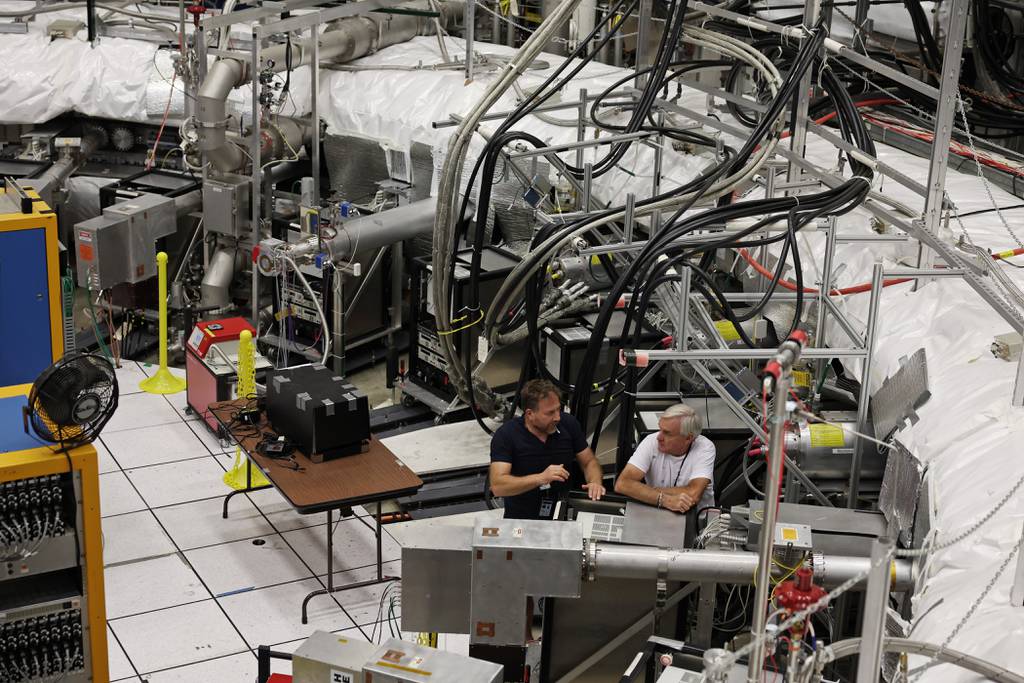Imagine trying to prove that 1+1=2, but when you do the calculations, it turns out that the result is off by .1%. That scenario is similar to the riddle facing physicists worldwide as they try to explain how the universe works in relation to a tiny particle called a muon.
Now, after years of excruciatingly exact experiments, researchers at Fermilab in Batavia have made new measurements of the muon that challenge the generally accepted laws of physics. The results, announced Thursday, potentially could lead to the discovery of new particles and expand the boundaries of physics.
“We’re really probing new territory” Fermilab senior scientist Brendan Casey said, speaking of the unprecedented precision of the work.
The riddle that physicists are trying to solve arose in 2001 when Brookhaven National Laboratory first announced measurements of the muon’s motion that differed from what physicists predicted.
The muon is a particle in atoms that is a more massive cousin of the electron, but it is unstable and decays in a few millionths of a second.
A muon is of course invisible to the human eye, but can be detected by the spin and wobble of its internal magnet. Like a canary in a coalmine, how it behaves alerts observers to every particle or force acting on it, both known and unknown.
A simple estimate based on the expected strength of the magnet, known as “g,” is 2. But Brookhaven found that the actual measurement was off by about .01 %. Physicists have struggled to explain that difference ever since. Theories include supersymmetry, in which each particle has a partner, something called lattice gauge theory, or that there could be other unseen factors or particles acting on the muon.
To zero in on the measurements of the muon, the giant 50-foot-around magnet that Brookhaven used was shipped to Fermilab in 2013. Fermi National Accelerator Laboratory, as it is formally known, generates muons traveling at nearly the speed of light, then runs the particles through a circular magnetic obstacle course to see how they interact with other particles.

Afternoon Briefing
Weekdays
Chicago Tribune editors’ top story picks, delivered to your inbox each afternoon.
After six years of experiments, Fermilab finished its measurements last month, and announced the latest results Thursday: g-2 = 0.00233184110 +/- 0.00000000043 (stat.) +/- 0.00000000019 (syst.).
The results, while incomprehensible to the average person, are twice as accurate as preliminary findings disclosed in 2021, and give further evidence of a disturbance in the force, so to speak, or an unexplained fluctuation in reality.
“This measurement is an incredible experimental achievement,” said Peter Winter, co-spokesperson for the Muon g-2 collaboration. “Getting the systematic uncertainty down to this level is a big deal and is something we didn’t expect to achieve so soon.”
The Muon g-2 team — made up of 182 collaborators from 33 institutions in seven countries — submitted its results in a paper to Physical Review Letters.
But there’s more work to do to be absolutely certain of the results. The latest announcement is based on just the first three years of measurements. Researchers still have three more years of data to crunch before they make a final pronouncement of their results.
The research is supported by multiple funding agencies in 7 different countries. The primary sponsor is the U.S. Department of Energy Office of Science, which invested $47 million into the main construction project, plus several other infrastructure projects.
Such basic research is unlikely to have immediate practical applications, but understanding of how sub-atomic particles work has led to advancements such as transistors, lasers and MRIs.






